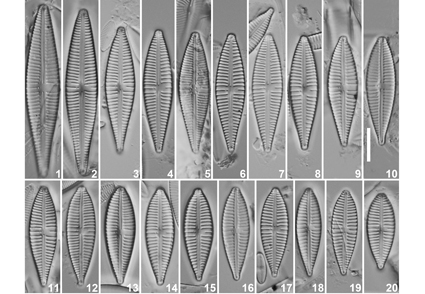Abstract
During a biomonitoring survey of the Flemish rivers, an unknown Gomphonema taxon was observed. After detailed light and scanning electron microscopy research and careful analysis with similar species in literature, the taxon is described as Gomphonema supersaprophilum sp. nov. The new species can be separated from similar species from the G. parvulum-saprophilum complex by its larger width, the shape of the head pole and the shape of the areolae. The new species was typically found in highly eutrophic waters.
References
- Abarca, N., Jahn, R., Zimmermann, J. & Enke, N. (2014) Does the cosmopolitan diatom Gomphonema parvulum (Kützing) Kützing have a biogeography? PLoS One 9 (1): e86885. https://doi.org/10.1371/journal.pone.0086885
- Abarca, N., Zimmermann, J., Kusber, W.-H., Mora, D., Van, A.T., Skibbe, O. & Jahn, R. (2020) Defining the core group of the genus Gomphonema Ehrenberg with molecular and morphological methods. Botany Letters 167 (1): 114–159. https://doi.org/10.1080/23818107.2019.1694980
- Abarca, N., Stancheva, R., Skibbe, O., Schimani, K., Kusber, W.-H., Zimmermann, J. & Jahn, R. (2023) Gomphadelpha (Bacillariophyceae) – a new genus name for taxa formerly subsumed in the Gomphoneis herculeana-group. Nova Hedwigia 117: 213–254. https://doi.org/10.1127/nova_hedwigia/2023/0859
- Agardh, C.A. (1827) Aufzählung einiger in den östreichischen Ländern gefundenen neuen Gattungen und Arten von Algen, nebst ihrer Diagnostik und beigefügten Bemerkungen. Flora oder Botanische Zeitung, Regensburg 10 (no. 40 of the second volume): 625–640.
- Cox, E.J. & Ross, R. (1981) The striae of pennate diatoms. In: Ross, R. (ed.) Proceedings of the Sixth Symposium on Recent and Fossil Diatoms. Budapest, September 1–5, 1980. Taxonomy · Morphology · Ecology · Biology. Otto Koeltz, Koenigstein. pp. 267–278.
- Grunow, A. (1862) Die österreichischen Diatomaceen nebst Anschluss einiger neuen Arten von andern Lokalitäten und einer kritischen Uebersicht der bisher bekannten Gattungen und Arten. In: Verhandlungen der kaiserlich-königlichen zoologisch-botanischen Gesellschaft in Wien, vol. 12. pp. 545–588. https://doi.org/10.5962/bhl.title.64361
- Guiry, M.D. & Guiry, G.M. (2019) AlgaeBase. World-wide electronic publication, National University of Ireland, Galway. Available from: https://www.algaebase.org (accessed: 15 December 2023).
- Hustedt, F. (1942) Süßwasser-Diatomeen des indomalayischen Archipels und der Hawaii-Inseln. Nach dem Material der Wallacea-Expedition. Internationale Revue der gesamten Hydrobiologie und Hydrographie 42 (1/3): 1–252. https://doi.org/10.1002/iroh.19420420102
- Jahn, R., Kusber, W.-H., Skibbe, O., Zimmermann, J., Van, A.T., Buczkó, K. & Abarca, N. (2019) Gomphonella olivacea (Bacillariophyceae)—a new phylogenetic position for a well-known taxon, its typification, new species and combinations. Plant Ecology and Evolution 152 (2): 219–247. https://doi.org/10.5091/plecevo.2019.1603
- Kützing, F.T. (1844) Die kieselschaligen Bacillarien oder Diatomeen. W. Köhne, Nordhausen, 144 pp., 30 pls. https://dx.doi.org/10.5962/bhl.title.64360
- Kützing, F.T. (1849) Species algarum. Lipsiae [Leipzig]: F.A. Brockhaus. pp. [i]–vi, [1]–922.
- Lange-Bertalot, H. (1979) Toleranzgrenzen und Populationsdynamik benthischer Diatomeen bei unterschiedlich starker Abwasserbelastung. Archiv für Hydrobiologie Supplement 56 (2): 184–219.
- Lange-Bertalot, H. (1980) Zur taxonomischen Revision einiger ökologisch wichtiger “Naviculae lineolatae“ Cleve. Die Formenkreise um Navicula lanceolata, N. viridula, N. cari. Cryptogamie, Algologie 1 (1): 29–50.
- Lange-Bertalot, H., Hofmann, G., Werum, M. & Cantonati, M. (2017) Freshwater benthic diatoms of Central Europe: over 800 common species used in ecological assessment. English edition with updated taxonomy and added species. Koeltz Botanical Books, Schmitten-Oberreifenberg, 942 pp.
- Levkov, Z., Mitic-Kopanja, D. & Reichardt, E. (2016) The diatom genus Gomphonema in the Republic of Macedonia. Diatoms of Europe 8: 1–552.
- Manguin, E. (1942) Contribution à la connaissance des Diatomées d’eau douce des Açores. Travaux Algologiques, Sér. 1. Muséum National d’Histoire Naturelle, Laboratoire de Cryptogamie 2: 115–160.
- Reichardt, E. (1999) Zur Revision der Gattung Gomphonema. Die Arten um G. affine/insigne, G. angustatum/micropus, G. acuminatum sowie gomphonemoide Diatomeen aus dem Oberoligozän in Böhmen. Iconographia Diatomologica 8: 1–203.
- Reichardt, E. (2018) Die Diatomeen im Gebiet der Stadt Treuchtlingen. Vols 1–2. Bayerische Botanische Gesellschaft, München, 1184 pp.
- Ross, R., Cox, E.J., Karayeva, N.I., Mann, D.G., Paddock, T.B.B., Simonsen, R. & Sims, P.A. (1979) An amended terminology for the siliceous components of the diatom cell. Nova Hedwigia, Beiheft 64: 513–533.
- Round, F.E. & Mann, D.G. (1981) The diatom genus Brachysira. I. Typification and separation from Anomoeoneis. Archiv für Protistenkunde 124 (3): 221–231.
- Smith, W. (1856) A synopsis of the British Diatomaceae; with remarks on their structure, functions and distribution; and instructions for collecting and preserving specimens. Vol. 2. John van Voorst, London, 107 pp., pls 32–60, 61–62, A–E. https://doi.org/10.5962/bhl.title.10706
- Turland, N.J., Wiersema, J.H., Barrie, F.R., Greuter, W., Hawksworth, D.L., Herendeen, P.S., Knapp, S., Kusber, W.-H., Li, D.-Z., Marhold, K., May, T.W., McNeill, J., Monro, A.M., Prado, J., Price, M.J. & Smith, G.F. (Eds.) (2018) International Code of Nomenclature for algae, fungi, and plants (Shenzhen Code) adopted by the Nineteenth International Botanical Congress Shenzhen, China, July 2017. Regnum Vegetabile, Vol. 159. Glashütten: Koeltz Botanical Books. pp. [i]–xxxviii, 1–253.
- van der Werff, A. (1955) A new method of concentrating and cleaning diatoms and other organisms. Verhandlungen der Internationalen Vereinigung für Theoretische und Angewandte Limnologie 12: 276–277. https://doi.org/10.1080/03680770.1950.11895297
- Wetzel, C.E., Ector, L., Van de Vijver, B., Compère, P. & Mann, D.G. (2015) Morphology, typification and critical analysis of some ecologically important small naviculoid species (Bacillariophyta). Fottea 15 (2): 203–234. https://doi.org/10.5507/fot.2015.020


